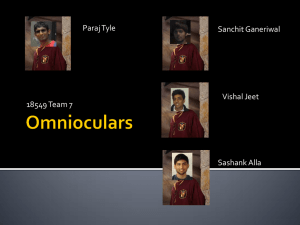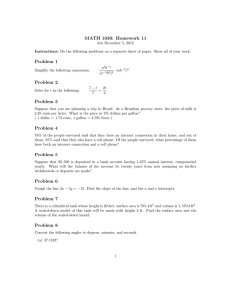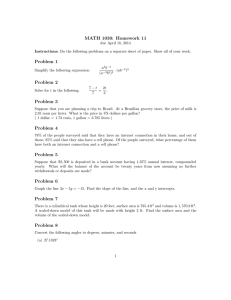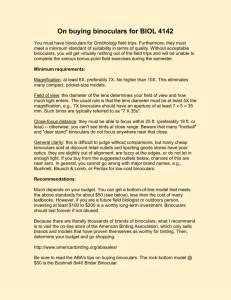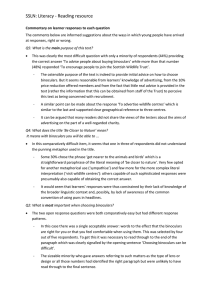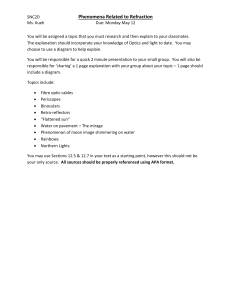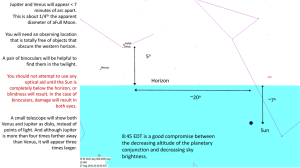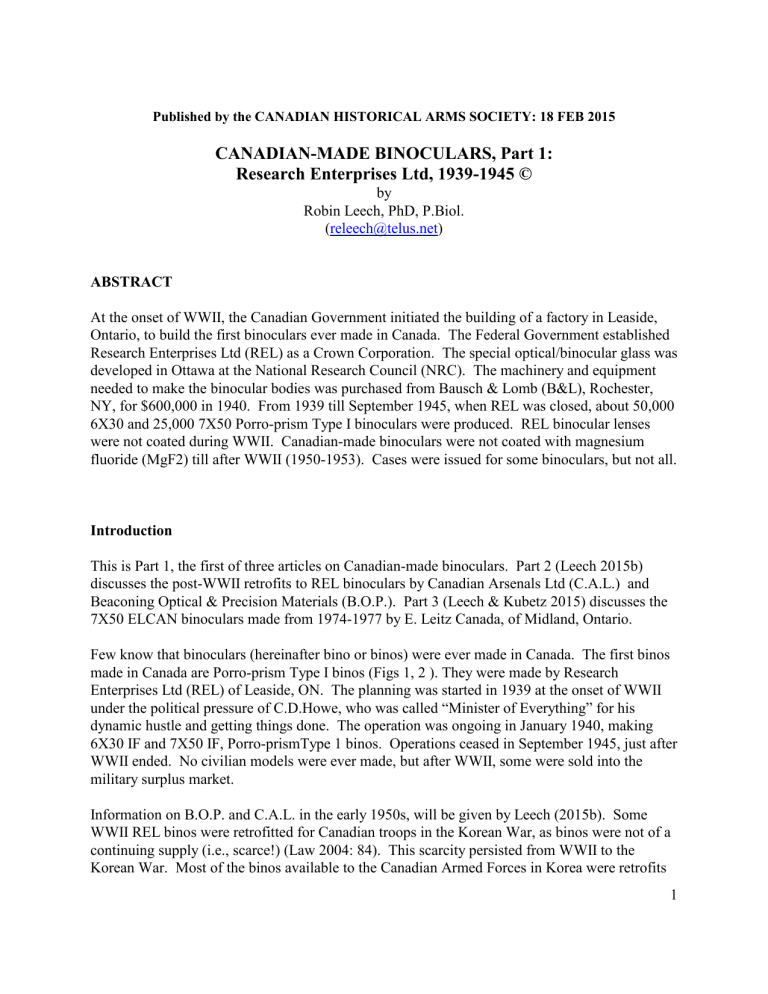
Published by the CANADIAN HISTORICAL ARMS SOCIETY: 18 FEB 2015 CANADIAN-MADE BINOCULARS, Part 1: Research Enterprises Ltd, 1939-1945 © by Robin Leech, PhD, P.Biol. (releech@telus.net) ABSTRACT At the onset of WWII, the Canadian Government initiated the building of a factory in Leaside, Ontario, to build the first binoculars ever made in Canada. The Federal Government established Research Enterprises Ltd (REL) as a Crown Corporation. The special optical/binocular glass was developed in Ottawa at the National Research Council (NRC). The machinery and equipment needed to make the binocular bodies was purchased from Bausch & Lomb (B&L), Rochester, NY, for $600,000 in 1940. From 1939 till September 1945, when REL was closed, about 50,000 6X30 and 25,000 7X50 Porro-prism Type I binoculars were produced. REL binocular lenses were not coated during WWII. Canadian-made binoculars were not coated with magnesium fluoride (MgF2) till after WWII (1950-1953). Cases were issued for some binoculars, but not all. Introduction This is Part 1, the first of three articles on Canadian-made binoculars. Part 2 (Leech 2015b) discusses the post-WWII retrofits to REL binoculars by Canadian Arsenals Ltd (C.A.L.) and Beaconing Optical & Precision Materials (B.O.P.). Part 3 (Leech & Kubetz 2015) discusses the 7X50 ELCAN binoculars made from 1974-1977 by E. Leitz Canada, of Midland, Ontario. Few know that binoculars (hereinafter bino or binos) were ever made in Canada. The first binos made in Canada are Porro-prism Type I binos (Figs 1, 2 ). They were made by Research Enterprises Ltd (REL) of Leaside, ON. The planning was started in 1939 at the onset of WWII under the political pressure of C.D.Howe, who was called “Minister of Everything” for his dynamic hustle and getting things done. The operation was ongoing in January 1940, making 6X30 IF and 7X50 IF, Porro-prismType 1 binos. Operations ceased in September 1945, just after WWII ended. No civilian models were ever made, but after WWII, some were sold into the military surplus market. Information on B.O.P. and C.A.L. in the early 1950s, will be given by Leech (2015b). Some WWII REL binos were retrofitted for Canadian troops in the Korean War, as binos were not of a continuing supply (i.e., scarce!) (Law 2004: 84). This scarcity persisted from WWII to the Korean War. Most of the binos available to the Canadian Armed Forces in Korea were retrofits 1 of WWII binos (Leech 2015b). I spoke with a retired Canadian officer who was in the Korean War, and he reported to me that there was only one pair of binos in his company (80-150 soldiers). He could not recall who used the binos, but they were most often used by mortar, artillery and machine gun crews. Porro-Prism Type I Binoculars Made by Research Enterprises Ltd (REL), Leaside, ON In 1939, the Canadian Government approved plans and funds for a factory to make binoculars. By January 1940 most of the machinery had been purchased mostly from Bausch & Lomb (B&L). By April 1940, samples of the bino components, including lens and prism glass, had been made and tested at a temporary plant of the National Research Council (NRC) in Ottawa, where workers were being trained. In June 1940, the plans for the factory had been drawn up, and by 16 July 1940, the Canadian Government had established REL. In August 1940, it was decided to build and place the factory, a Crown Corporation, at Leaside, in Toronto, ON. At this point, $600,000 worth of equipment was ordered from B&L, Rochester, NY. Remember, those were 1940 dollars. Construction of the factory started on 16 September 1940, and by 5 June 1941, the first melt of optical glass was in production by the NRC in Ottawa, and by November 1941, REL was producing 5.5 tons per month (Bolton 1990). The first goal was to produce optical/binocular glass and rangefinders of the Barr & Stroud type (and radar equipment). Dr R.J. Montgomery, formerly in charge of optical glass at B&L in Rochester, New York, was brought on board. REL was also assisted by the U.S. Bureau of Standards, and the British Admiralty. B&L trained 9 glass polishers for REL. As in Australia and other Commonwealth Countries, there had been few instrument makers before the war, and Canada hoped that its local optical industry would not lapse after the war (Bolton 1990). REL, from 1941 through to 1945, made about 50,000 units of 6X30 binos, and about 25,000 units of 7X50 binos, along with leather carrying cases for some of them (on the prism covers, G.A. indicates that a case was issued with the binoculars, and M.A. means that no case issued). See Fig. 1 for the 6X30 with carrying case; Fig. 2 for the 7X50 with carrying case. My REL binoculars do not have a Mil and Range scale reticule, and the lenses are not coated. Construction of the factory started on 16 September 1940, and by 5 June 1941, the first melt of optical glass was in production by the NRC in Ottawa, and by November 1941, REL was producing 5.5 tons per month (Bolton 1990). The first goal was to produce optical/binocular glass and rangefinders of the Barr & Stroud type (and radar equipment). Dr R.J. Montgomery, formerly in charge of optical glass at B&L in Rochester, New York, was brought on board. REL was also assisted by the U.S. Bureau of Standards, and the British Admiralty. B&L trained 9 glass polishers for REL. As in Australia and other Commonwealth Countries, there had been few instrument makers before the war, and Canada hoped that its local optical industry would not lapse after the war (Bolton 1990). 2 Fig. 1. REL 6X30 Porro-prism Type I binos with issued bino strap and case with shoulder strap. The case is impressed with the initials ‘R.E.L.- CANADA”. Note the classic B&L shape. REL, from 1941 through to 1945, made about 50,000 units of 6X30 binos, and about 25,000 units of 7X50 binos, along with leather carrying cases for some of them (on the prism covers, G.A. indicates that a case was issued with the binoculars, and M.A. means that no case issued). See Fig. 1 for the 6X30 with carrying case; Fig. 2 for the 7X50 with carrying case. My REL binoculars do not have a Mil and Range scale reticule, and the lenses are not coated lenses. Construction of the factory started on 16 September 1940, and by 5 June 1941, the first melt of optical glass was in production by the NRC in Ottawa, and by November 1941, REL was producing 5.5 tons per month (Bolton 1990). The first goal was to produce optical/binocular glass and rangefinders of the Barr & Stroud type (and radar equipment). Dr R.J. Montgomery, formerly in charge of optical glass at B&L in Rochester, New York, was brought on board. REL was also assisted by the U.S. Bureau of Standards, and the British Admiralty. B&L trained 9 glass polishers for REL. As in Australia and other Commonwealth Countries, there had been few instrument makers before the war, and Canada hoped that its local optical industry would not lapse after the war (Bolton 1990). 3 Fig. 2. REL 7X50 Porro-prism Type I binos with issued bino strap and case with shoulder strap. This case is also impressed with “R.E.L.- CANADA”. Note the yellow-painted Broad Arrow carved into the leatherette. Markings on the prism covers of both the 6X30 and 7X50 REL need explanation: 6X30 Porro-prism Type I bino, IF (Individual Focus). (Fig. 3 below) Left Prism Cover: - C.G.B. = Consignment [to] Great Britain - 56 G.A. Series 56; “G.A.” indicates the binos were issued with a case. - 6X30 Bino specs, 6X magnification and 30 mm objective. - 8974-C Serial number of the binos. Right Prism Cover: - R.E.L./CANADA = Made by Research Enterprises Ltd, Leaside, ON, Canada. - 1943. Year of manufacture. - Broad Arrow (Crow’s Foot or Trident) with Capital Letter “C” surrounding the Broad Arrow (see Fig. 5). Broad Arrow is for Military (Government), and capital letter “C” is for Canada. The 6X30 binos weigh 0.65 kg, and with neck strap and case 1.16 kg. 4 Fig. 3. REL 6X30 binos showing prism plate data. See explanation above. 7X50 Porro-prism Type I bino, IF (Individual Focus). (Fig. 4 below) Left Prism Cover: - C.G.B. = Consignment [to] Great Britain. - 57 G.A. Series 57; “G.A” indicates the binos were issued with a case. - 7X50 Bino specs, 7X magnification and 50 mm objectives. - 6891-C Serial number of the binos. - hand-painted red “W” means waterproof (see below, Seeger 1996/2002:61). Right Prism Cover: (Fig. 5 below) . - R.E.L./Canada = Made by Research Enterprises Ltd, Leaside, ON, Canada. - 1944. Year of manufacture. Carved into the protective leatherette covering on the upper side of both body tube covers, just above the objective lens, and painted in vivid yellow, is the British Broad Arrow (aka Trident or Crow’s Foot). The 7X50 binoculars weigh 1.45 kg, and with neck strap and case 2.20 kg. None of the lenses or prisms in either the 6X30 or 7X50 binos in the RELs I have seen is coated. When the left prism plate of the REL 7X50 has a hand-painted red “W” (Fig. 4), it means these binos have been water-proofed (Seeger 1996/2002: 61) [‘…:ein weiteres ähnliches REL 7X50…, hat links in Rot den Buchstaben “W” aufgestempelt Bedeutung wahrscheinlich “Waterproof”, ….][transl.: “…another similar REL 7X50 . . . has on the left prism cover a stamped, red-painted ‘W’ probably meaning ‘Waterproof’. “]. Both the right and left prism plates have two screws with gaskets for moisture purging, rather than one as seen in Rohan (2001: 157). Some of the 5 REL 7X50s with a single prism plate screw, also have a single bino body screw near the objective lens, have had these screws painted red (Fig. 4a), but these may have been painted in a 1950 retrofit by Canadian Armories Ltd (C.A.L.) (see Leech & Lagorio, in prep.). Ross Porroprism Type II binos (Fig. 6, red-painted purge screws) were nitrogen purged to prevent fogging. Fig. 4. REL 7x50 Porro-prism Type I binos, left prism cover data. See explanation above. Red “W” indicates waterproof. Note the two purging screws on the prism plate. Fig. 4a. REL 7X50 retrofitted in 1950 by C.A.L. for use in the Korean War. Note the red-painted purge screw. 6 Fig. 5. REL 7X50 Porro-prism Type I binos, right prism cover data. See explanation above. None of the lenses or prisms in either the 6X30 or 7X50 binos in the RELs I have seen is coated. Further, none of these was made water-proof, and they do not have the nitrogen-purging screws and gaskets commonly seen on red-painted screws in the high-end British-made Porro-prism Type II binos (e.g., Ross, London, Fig.6, below) used during WWII to prevent fogging. Fig. 6. Ross, London, 7X50 Porro-prism Type II binos. 7 The red screws and gaskets are ports for nitrogenpurging to ensure water-proofing and anti-fogging. 1945. The lenses are coated, perhaps after WWII. The REL 7X50s have the usual leatherette material to protect the bodies of the binoculars. In contrast, the bodies of the REL 6X30s are coated with a black, thin, reticulated or textured paint (crinkle finish?) that covers the metal. The prism covers and the objective ends of the bodies stick out from and around the bodies. This indicates that though the original plan was to have the bodies covered with a leatherette protective layer, there may have been a change to reduce production costs. Fig. 7. Ross, London, 7X50 Porro-prism Type II. Note the tin-can shape of the prism housing. Dated 1945. The lenses are coated, possibly done post-WWII. As would be expected, the outline image of both of these REL binoculars is identical to those for the equivalent B&L binoculars. The reason is that Canadian Government had purchased the needed equipment from B&L for binocular making, then gave the equipment to REL to make the 8 6X30 and 7X50 sizes of binoculars. There were also about 6 experimental 20X72 units made. REL made other optical equipment for military purposes. Other optical equipment included predictors (used on naval guns), tank periscopes, rifle scopes, and sighting telescopes. Optical research work was done at the NRC in Ottawa, and included improving the aerial photography lenses. Because of German airplane activity over UK, search lights, etc., night photography was impossible to do in the UK. The optical improvements for aerial photography equipment were done in Ottawa, and also in Australia (Bolton, 1990). To have maintained the initiative here for a binocular industry in Canada could have been done, but it would have needed a federal impetus and support. Also needed would have been more models of binoculars and greater numbers. There was a lost opportunity for Canada here. The Australians felt the same loss of opportunity (Bolton 1990). I should mention here that few binos made in the USA early on during WWII had coated optics and prisms. A few firms, such as B&L, Wollensak, Universal, Kollsman, SARD, Spencer (AO), Nash Kelvinator and others, made some binos, but not all binos, with coated optics and prisms. Coated optics and prisms were more common possibly in late 1942, but definitely by early 1943. Remember, the Americans did not enter WWII until war was declared against Japan on 8 December 1941, one day after Pearl Harbor was bombed. For a comparative note, pair of Ross, London, binos, dated 1942, does not have coated lenses. By 1945, the Ross, London, binos have coated lenses (or, it is possible that they were coated post-WWII). Thus the American lenscoating technology was passed on to at least the UK post-WWII, but the technology was not applied to REL-made binoculars during WWII. I have yet to confirm if the REL lenses were coated in 1945, or were post-WWII retrofits of the 1950s for use in the Korean War. Bausch & Lomb had been applying its own special BALCOTE (in-house name for magnesium fluoride, MgF2, coating) since 1939 for commercial purpose optics. BALCOTE is a thin, transparent film that was applied to all air-to-glass surfaces, and resulted in cutting light loss by as much as 50% for WWII binoculars (Bausch & Lomb 1950: 13, and for binoculars made after WWII, as much as 78% (Bausch & Lomb 1950: 17). Application of BALCOTE to binocular lenses increased both the contrast and apparent resolution by giving clearer, sharper images. Wollensak’s 6X30 M5 binos most likely had the MgF2 coatings, which Wollensak called WOCOTE, as early as 1940 or 1941. The Wollensak 6X30 M5 binos were made strictly for use by Commonwealth Countries. This will be discussed in more detail by Leech & Lagorio (in preparation). But not all binoculars issued to the US Armed Forces had either the B&L BALCOTE, WOCOTE or magnesium fluoride lens coatings. Coating of some or all air-to-glass surfaces seems to have been erratic (see this paragraph). Even if the objectives or oculars were coated, the other may not have been. I have no information on the inner glass surfaces. The examples I have at hand are these: SARD 7X50 BU. AERO. U.S. Navy (oculars coated, objectives not coated), no issue date; SARD 7X50, U.S. BUSHIPS, MARK XLIV, MOD. 0, SN 401372, with “Coated Optics” sticker, 1944 (see Figs 8 and 9 below) ; 9 2 pairs of SARD 6x42 Mark 43, Wide Field, BU. AERO. U.S.Navy, coated optics, 1943-44, Stock No. R88-B-303 (no serial #); Spencer (AO), Buffalo, USA, 7X50 U.S. Navy–BUSHIPS, Mark III, Mod. 5, 1941, optics not coated; B&L 6X30, U.S. Navy. BUSHIPS, Mark III, Mod, 1. 4222–1940, objectives coated, oculars not coated; and, HAYWARD, U.S. Navy-BUSHIPS, Mark 45, Model 0, SN 314311, 1944, blue-purple coating at least on all external lenses, and has a “Coated Optics” sticker as in Fig. 8. Perhaps by as early as 1942 (but by 1943 certainly) binoculars with lens coatings were being issued to the US Navy. The main problem was that binoculars available to Allied military were in very short supply. Several countries such as Australia (Bolton 1990) and the US impressed binoculars from the public. In Australia, of some 18,500 binoculars impressed, only about 8,000 were good enough for military use (Bolton 1990). It was not till late 1944 and 1945 that binoculars started arriving in numbers, and some of those were RELs and US-made binoculars that were sent to Australia. This did not impress the Australians, as the US Government even asked Australia if it could supply 1.3 million optical parts. This was well beyond the capacity of Australia (Bolton 1990). For SARD, binoculars with coatings were being issued by at least 12 July 1944 (Fig. 8). These are newly made, non-B&L binoculars issued to the US Navy Quartermaster Corps which had coated optics (Figs 8 & 9). There was a special sticker (Fig. 9) attached to the new binoculars that reads, “This instrument has COATED OPTICS Clean Lenses Carefully”. Fig. 9 shows a new, yet-to-be-issued pair of 7X50 SARD binoculars sent to the US Navy Quartermaster Corps. Fig. 10 shows the same sticker on a pair of used 6X30 Wollensak M5 binoculars issued and used in the field, most likely by the Australians. Coated optics for all military binoculars occurred in the US by at least mid-1944. The coatings were very soft compared to today’s harder optic coatings, hence the warning to clean the lenses carefully. After WWII, many of the binoculars either not issued by the Quartermaster Corps, or used by the US Armed Forces but lacking coated optics, were returned to the manufacturer. Scratched or nicked lenses could not be coated, so binoculars with these problems were stripped of the faulty lenses. The returned binoculars were factory coated; many were returned either to military use after WWII, or sold as surplus. 10 Fig. 8. Box with SARD 7X50 binos received by the US Navy Quartermaster Corps, but never issued. Note date: 12 Jul 1944. This is the earliest dated record I could find for coated bino lenses, other than those by B&L for to the US or UK Navy during WWII. Fig. 9. SARD, 7X50 Porro-prism Type I binocs, not issued by the Quartermaster Corps. Note the “COATED OPTICS” sticker. 11 Fig. 10. Wollensak 6X30 binos. These were issued with a “COATED OPTICS” sticker. Note the shape of these binos. The objective lenses attach to the prism covers. These are very light, have a very narrow FoV, and have a right-eye reticle as is typical for non-US military use. Probably used in Papua New Guinea in late 1942 or early 1943. A comment offered by several Canadian soldiers, who fought in Europe during WWII, is that when German soldiers were captured, their binoculars were always taken as they were considered to be of high quality. This is only partly true. A greater reason was that binoculars of any kind were scarce. A few of the German binocular lenses were coated, which added to the image brightness (Cicala 2011: 3). They were also good German war booty. Most were 6X30s, but some were 8X30s. Though some of these captured binoculars had coated lenses, they were not nitrogen-purged. The binoculars issued to Canadians, the non-coated RELs, were passed on to other Canadian officers. Canadian officers, but not the NCOs, were issued binoculars. Perhaps Law (2004: 84) stated the real reason behind the keeping of the enemy’s binoculars: “Binoculars were not listed as an item ‘of continuing Canadian supply’ so binoculars of any make could be found in use by Canadians.” There are several other articles regarding binoculars I have written that may be of interest: Leech 2014a; 2014b; 2014c; 2014d; 2014e; 2015b; Leech & Kubetz 2105. These are published, so electronic copies are available for the asking from: releech@telus.net. Are There Advantages of Porro-Prism Type Binoculars over Roof-Prism Type Binoculars? There used to be distinct advantages of Porro-prism Type binoculars over roof-prism Type binoculars, but not since 2005 when new kinds of lens coatings (e.g., phase-coating and 12 dielectric- coating) were developed (Leech 2014d). Smaller roof-prism binoculars (e.g., 8X20) can be folded to fit into a pocket, and they may handle more easily than do Porro-prism binoculars. But, Porro-prism Type I & II binoculars offer one distinct advantage over roof-prism binoculars: Porro-prism binoculars have the objective lenses farther apart than are the oculars, which are set at your inter-pupillary (I-P) distance. This gives the Porro-prism binoculars a distinct edge for stereo or 3-D interpretation of objects up to and shortly beyond 100 m. In comparison, the roof-prism binoculars have the same I-P distance for both the ocular and objective lenses. Conclusions The REL binoculars are of interest from the historical military equipment perspective, and during WWII, they certainly met the military needs of Canada, the UK and a few other Commonwealth countries. But they are nothing special for use today, and do not offer as much as can be had with many modern-day binoculars with coated optics. The comment from WWII users of the REL binoculars is that the German equivalents are better, mainly because the German binoculars were lighter and have coated optics. This may be true, but only partly so. Because of a shortage of binoculars for Canadian officers and NCOs, Leitz, Zeiss, Busch or any German binoculars were appropriated as opportunities arose. Until 2005, Porro-prism binoculars inherently offered better resolution, contrast and brightness because roof-prism binoculars employ silvered surfaces that reduce light transmission by 12-15%. Further, roof-prism binoculars require tighter tolerances for alignment of their optical elements (collimation) (Binoculars 2014). All data and figures were taken from binoculars in the author’s collection. Acknowledgements My brother, Tom Leech, an engineer and a binocular and telescope specialist, is thanked for information provided from the prism covers of his WWII binoculars, and for reviewing and commenting on the manuscript. Dr Hans Seeger is thanked for numerous related, informative emails over several years, all related to binoculars, and for the gift of his book on military binoculars and telescopes. Blair Hault of Edmonton is thanked for information on the role of the US Quartermaster Corps in relation to the US armed forces. Peter Abrahams is thanked for advice and information on people contacts. Al Kerr, owner of the Milarm Museum, Edmonton, is thanked for loaning me his collection of Canadian-made binoculars (REL retrofits of 1950) for examination and picture taking. Gord McGowan of Milarm, Edmonton, and Frank Lagorio, Winnipeg, are thanked for carefully checking the manuscript. And lastly, my wife, Lorie, who has come to enjoy and better understand the use of binoculars for watching birds in our back yard. References The format used for citing the references is the Scientific Style and Format, which is the “CBE Style Manual for Authors, Editors and Publishers, and covering the physical sciences and mathematics, as well as the life sciences”. ISBN: 0-521-47154-0 Hardback. 1994 edition. 13 Abrahams, P. 2009. The history of the telescope & the binocular. On line search, 31 July 2014. www.europa.com/~telscope/binotele/htm. Abrahams, P. 2014. Personal Communication, phone calls, Emails and advice. August and September 2014. Bausch & Lomb. 1950. Binoculars and how to use them. Bausch & Lomb Optical Company, Rochester, New York. 30 pages. Binoculars. 2014. Wikipedia. http://en.wikipedia.org/wiki/Binoculars. 15 p. Updated at 17:42h on 16 September 2014. Search Date: 19 October 2014. Bolton, H.C. 1990. Optical instruments in Australia in the 1939-45 war: successes and lost opportunities. Australian Physicist 27(3): 22 pages. Cicala, R. 2011. All about lens coatings. www.canonrumors.com-tech/all about lens coatings. Posted 17 December 2011. 7 pages. (2011). Accessed 12 October 2014. Law, C.M. 2004. Without Warning. Service Publications, Ottawa. 87 pp, 175 figs. ISBN: 1-894581-16-4. Leech, R. 2014a. Binoculars, Part I. Introduction. Canadian Historical Arms Society. CHAS News, September 2014. chas_news@yahoo.ca. Leech, R. 2014b. Binoculars, Part II. Prisms, holding steady. Canadian Historical Arms Society. CHAS News, October 2014. chas_news@yahoo.ca. Leech, R. 2014c. Age vs Dilated Eye Pupil Size: factors to consider regarding your eyes and binoculars used for biological research, birding and hunting. AHEIA Conservation Education Magazine. Fall 2014, pp. 22-23, 3 figs. Leech, R. 2014d. Binoculars, Part 3. Terms/Definitions/Glossary. Canadian Historical Arms Socitey. CHAS News, November 2014. chas_news@yahoo.ca. Leech, R. 2014e. Binocular fields of view, Part 4. Canadian Historical Arms Society. CHAS News, November 2014. chas_news@yahoo.ca. Leech, R. 2015b. Canadian-made binoculars, Part 2. BOP & CAL retrofits of RELs in the early 1950s. Canadian Historical Arms Society Website. February, 2015. 13 pages, 11 figs. Leech, R., & K.Kubetz. 2015. Canadian-made binoculars, Part 3. ELCAN roof-prism military & civilian versions. Canadian Historical Arms Society Website. February 2015. 14 12 pages, 10 figs. Rohan, S. 2001. A guide to handheld military binoculars, 1894-1945. Optical Press, Bradbury, California. iv+183 p., well-illustrated. ISBN: 0-9709003-0-9. Seeger, Hans. 1996/2002. Militärische Ferngläser und Fernrohre in Heer, Luftwaffe und Marine (Military Binoculars and Telescopes for Land, Air and Sea Service). 537 p., 320 figs. Druckerei Kempkes, D-35067 Gladenbach. ISBN: 3-00-000457-2. 15
